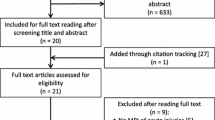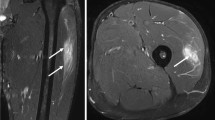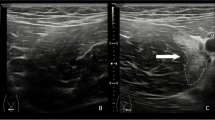Abstract
Purpose of Review
Hamstring muscle injuries are common amongst athletes and can result in significant time away from sport. This review article evaluates and discusses the current literature on magnetic resonance imaging (MRI) vs. musculoskeletal ultrasound (US) for prevention, diagnosis, and management of hamstring muscle injuries.
Recent Findings
MRI has commonly been used for diagnosis of hamstring injuries and can offer prognostic information regarding return to play. US offers similar clinical information with some notable advantages over MRI.
Summary
US is a valuable imaging modality that can be used for diagnosis and prognosis of hamstring injuries and also help guide return to play after injury.

Similar content being viewed by others
References
Pollock N, James SLJ, Lee JC, Chakraverty R. British athletics muscle injury classification: a new grading system. Br J Sports Med. 2014;48(18):1347. https://doi.org/10.1136/bjsports-2013-093302.
Mueller-Wohlfahrt H-W, Haensel L, Mithoefer K, Ekstrand J, English B, McNally S, et al. Terminology and classification of muscle injuries in sport: the Munich consensus statement. Br J Sports Med. 2013;47(6):342. https://doi.org/10.1136/bjsports-2012-091448.
Valle X, Alentorn-Geli E, Tol JL, Hamilton B, Garrett WE Jr, Pruna R, et al. Muscle injuries in sports: a new evidence-informed and expert consensus-based classification with clinical application. Sports Med. 2017;47(7):1241–53. https://doi.org/10.1007/s40279-016-0647-1.
Hall MM. Return to play after thigh muscle injury: utility of serial ultrasound in guiding clinical progression. Curr Sports Med Rep. 2018;17(9):296–301. https://doi.org/10.1249/jsr.0000000000000516.
Pollock N, Patel A, Chakraverty J, Suokas A, James SLJ, Chakraverty R. Time to return to full training is delayed and recurrence rate is higher in intratendinous (‘c’) acute hamstring injury in elite track and field athletes: clinical application of the British Athletics Muscle Injury Classification. Br J Sports Med. 2016;50(5):305. https://doi.org/10.1136/bjsports-2015-094657.
Buckthorpe M, Wright S, Bruce-Low S, Nanni G, Sturdy T, Gross AS, et al. Recommendations for hamstring injury prevention in elite football: translating research into practice. Br J Sports Med. 2019;53(7):449. https://doi.org/10.1136/bjsports-2018-099616.
Wangensteen A, Guermazi A, Tol JL, Roemer FW, Hamilton B, Alonso J-M, et al. New MRI muscle classification systems and associations with return to sport after acute hamstring injuries: a prospective study. Eur Radiol. 2018;28(8):3532–41. https://doi.org/10.1007/s00330-017-5125-0.
Greenky M, Cohen SB. Magnetic resonance imaging for assessing hamstring injuries: clinical benefits and pitfalls - a review of the current literature. Open Access J Sports Med. 2017;8:167–70. https://doi.org/10.2147/OAJSM.S113007.
Becciolini M, Bonacchi G, Bianchi S. Ultrasound features of the proximal hamstring muscle-tendon-bone unit. J Ultrasound Med. 2019;38(5):1367–82. https://doi.org/10.1002/jum.14804.
Nazarian LN. The top 10 reasons musculoskeletal sonography is an important complementary or alternative technique to MRI. AJR Am J Roentgenol. 2008;190(6):1621–6. https://doi.org/10.2214/ajr.07.3385.
O’Donoghue DO. The treatment of injuries to athletes. Philadelphia: WB Saunders; 1962.
Ryan A. Quadriceps strain, rupture and charlie horse. Med Sci Sports. 1969;1:106–11.
Takebayashi S, Takasawa H, Banzai Y, Miki H, Sasaki R, Itoh Y, et al. Sonographic findings in muscle strain injury: clinical and MR imaging correlation. J Ultrasound Med. 1995;14(12):899–905.
Chan O, Del Buono A, Best TM, Maffulli N. Acute muscle strain injuries: a proposed new classification system. Knee Surg Sports Traumatol Arthrosc. 2012;20(11):2356–62. https://doi.org/10.1007/s00167-012-2118-z.
Peetrons P. Ultrasound of muscles. Eur Radiol. 2002;12(1):35–43. https://doi.org/10.1007/s00330-001-1164-6.
Maffulli N, Del Buono A, Oliva F, Giai Via A, Frizziero A, Barazzuol M, et al. Muscle injuries: a brief guide to classification and management. Transl Med UniSa. 2015;12:14–8.
van der Horst N, van de Hoef S, Reurink G, Huisstede B, Backx F. Return to play after hamstring injuries: a qualitative systematic review of definitions and criteria. Sports Med. 2016;46(6):899–912. https://doi.org/10.1007/s40279-015-0468-7.
de Visser HM, Reijman M, Heijboer MP, Bos PK. Risk factors of recurrent hamstring injuries: a systematic review. Br J Sports Med. 2012;46(2):124–30. https://doi.org/10.1136/bjsports-2011-090317.
Patel A, Chakraverty J, Pollock N, Chakraverty R, Suokas AK, James SL. British athletics muscle injury classification: a reliability study for a new grading system. Clin Radiol. 2015;70(12):1414–20. https://doi.org/10.1016/j.crad.2015.08.009.
Rubin DA. Imaging diagnosis and prognostication of hamstring injuries. AJR Am J Roentgenol. 2012;199(3):525–33. https://doi.org/10.2214/ajr.12.8784.
Freckleton G, Pizzari T. Risk factors for hamstring muscle strain injury in sport: a systematic review and meta-analysis. Br J Sports Med. 2013;47(6):351–8. https://doi.org/10.1136/bjsports-2011-090664.
van Heumen M, Tol JL, de Vos RJ, Moen MH, Weir A, Orchard J, et al. The prognostic value of MRI in determining reinjury risk following acute hamstring injury: a systematic review. Br J Sports Med. 2017;51(18):1355–63. https://doi.org/10.1136/bjsports-2016-096790.
Connell DA, Schneider-Kolsky ME, Hoving JL, Malara F, Buchbinder R, Koulouris G, et al. Longitudinal study comparing sonographic and MRI assessments of acute and healing hamstring injuries. AJR Am J Roentgenol. 2004;183(4):975–84. https://doi.org/10.2214/ajr.183.4.1830975.
Svensson K, Alricsson M, Eckerman M, Magounakis T, Werner S. The correlation between the imaging characteristics of hamstring injury and time required before returning to sports: a literature review. J Exerc Rehabil. 2016;12(3):134–42. https://doi.org/10.12965/jer.1632558.279.
Petersen J, Thorborg K, Nielsen MB, Skjødt T, Bolvig L, Bang N, et al. The diagnostic and prognostic value of ultrasonography in soccer players with acute hamstring injuries. Am J Sports Med. 2014;42(2):399–404. https://doi.org/10.1177/0363546513512779.
Askling CM, Tengvar M, Thorstensson A. Acute hamstring injuries in Swedish elite football: a prospective randomised controlled clinical trial comparing two rehabilitation protocols. Br J Sports Med. 2013;47(15):953–9. https://doi.org/10.1136/bjsports-2013-092165.
Petersen J, Thorborg K, Nielsen MB, Budtz-Jørgensen E, Hölmich P. Preventive effect of eccentric training on acute hamstring injuries in men’s soccer: a cluster-randomized controlled trial. Am J Sports Med. 2011;39(11):2296–303. https://doi.org/10.1177/0363546511419277.
Mjølsnes R, Arnason A, Østhagen T, Raastad T, Bahr R. A 10-week randomized trial comparing eccentric vs. concentric hamstring strength training in well-trained soccer players. Scand J Med Sci Sports. 2004;14(5):311–7. https://doi.org/10.1046/j.1600-0838.2003.367.x.
Tyler TF, Schmitt BM, Nicholas SJ, McHugh MP. Rehabilitation after hamstring-strain injury emphasizing eccentric strengthening at long muscle lengths: results of long-term follow-up. J Sport Rehabil. 2017;26(2):131–40. https://doi.org/10.1123/jsr.2015-0099.
Chumanov ES, Schache AG, Heiderscheit BC, Thelen DG. Hamstrings are most susceptible to injury during the late swing phase of sprinting. Br J Sports Med. 2012;46(2):90. https://doi.org/10.1136/bjsports-2011-090176.
Guex K, Degache F, Morisod C, Sailly M, Millet GP. Hamstring architectural and functional adaptations following long vs. short muscle length eccentric training. Front Physiol. 2016;7:340. https://doi.org/10.3389/fphys.2016.00340.
Brockett CL, Morgan DL, Proske U. Predicting hamstring strain injury in elite athletes. Med Sci Sports Exerc. 2004;36(3):379–87. https://doi.org/10.1249/01.mss.0000117165.75832.05.
Potier TG, Alexander CM, Seynnes OR. Effects of eccentric strength training on biceps femoris muscle architecture and knee joint range of movement. Eur J Appl Physiol. 2009;105(6):939–44. https://doi.org/10.1007/s00421-008-0980-7.
Timmins RG, Shield AJ, Williams MD, Lorenzen C, Opar DA. Architectural adaptations of muscle to training and injury: a narrative review outlining the contributions by fascicle length, pennation angle and muscle thickness. Br J Sports Med. 2016;50(23):1467–72. https://doi.org/10.1136/bjsports-2015-094881.
Timmins RG, Bourne MN, Shield AJ, Williams MD, Lorenzen C, Opar DA. Short biceps femoris fascicles and eccentric knee flexor weakness increase the risk of hamstring injury in elite football (soccer): a prospective cohort study. Br J Sports Med. 2016;50(24):1524–35. https://doi.org/10.1136/bjsports-2015-095362.
Guex K, Degache F, Morisod C, Sailly M, Millet GP. hamstring architectural and functional adaptations following long vs. short muscle length eccentric training. Front Physiol. 2016;7:340. https://doi.org/10.3389/fphys.2016.00340.
Alonso-Fernandez D, Docampo-Blanco P, Martinez-Fernandez J. Changes in muscle architecture of biceps femoris induced by eccentric strength training with nordic hamstring exercise. Scand J Med Sci Sports. 2018;28(1):88–94. https://doi.org/10.1111/sms.12877.
Presland JD, Timmins RG, Bourne MN, Williams MD, Opar DA. The effect of Nordic hamstring exercise training volume on biceps femoris long head architectural adaptation. Scand J Med Sci Sports. 2018;28(7):1775–83. https://doi.org/10.1111/sms.13085.
Fyfe JJ, Opar DA, Williams MD, Shield AJ. The role of neuromuscular inhibition in hamstring strain injury recurrence. J Electromyogr Kinesiol. 2013;23(3):523–30. https://doi.org/10.1016/j.jelekin.2012.12.006.
Timmins RG, Shield AJ, Williams MD, Lorenzen C, Opar DA. Biceps femoris long head architecture: a reliability and retrospective injury study. Med Sci Sports Exerc. 2015;47(5):905–13. https://doi.org/10.1249/mss.0000000000000507.
Klimstra M, Dowling J, Durkin JL, MacDonald M. The effect of ultrasound probe orientation on muscle architecture measurement. J Electromyogr Kinesiol. 2007;17(4):504–14. https://doi.org/10.1016/j.jelekin.2006.04.011.
Noorkoiv M, Stavnsbo A, Aagaard P, Blazevich AJ. In vivo assessment of muscle fascicle length by extended field-of-view ultrasonography. J Appl Physiol (1985). 2010;109(6):1974–9. https://doi.org/10.1152/japplphysiol.00657.2010.
Franchi MV, Fitze DP, Raiteri BJ, Hahn D, SpÖrri J. Ultrasound-derived biceps femoris Long head fascicle length: extrapolation pitfalls. Med Sci Sports Exerc. 2020;52(1):233–43. https://doi.org/10.1249/mss.0000000000002123.
Bennett HJ, Rider PM, Domire ZJ, DeVita P, Kulas AS. Heterogeneous fascicle behavior within the biceps femoris long head at different muscle activation levels. J Biomech. 2014;47(12):3050–5. https://doi.org/10.1016/j.jbiomech.2014.06.032.
Author information
Authors and Affiliations
Corresponding author
Ethics declarations
Conflict of Interest
The authors declare no competing interests.
Human and Animal Rights and Informed Consent
This article does not contain any studies with human or animal subjects performed by any of the authors.
Additional information
Publisher's Note
Springer Nature remains neutral with regard to jurisdictional claims in published maps and institutional affiliations.
This article is part of the Topical Collection on Musculoskeletal Rehabilitation
Rights and permissions
About this article
Cite this article
Kruse, R.C., Whipple, M.T., Schmidt, E. et al. Role of Ultrasound in Managing Hamstring Muscle Injuries. Curr Phys Med Rehabil Rep 9, 237–242 (2021). https://doi.org/10.1007/s40141-021-00330-7
Accepted:
Published:
Issue Date:
DOI: https://doi.org/10.1007/s40141-021-00330-7




